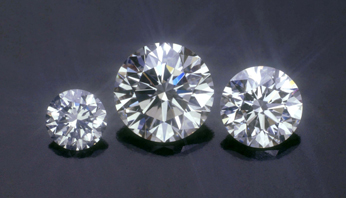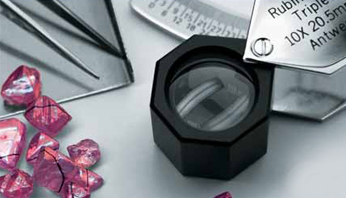How to Care your Diamond
Diamonds are the hardest known substances on earth. But this doesn’t mean that they are un destroyable. While they can be cut and polished only by another diamond, a hard blow can chip it. So never wear diamond jewelry while doing rough work.
Exposing diamond to high heat can damage the surface of the stone. This happens occasionally when jewellery repair is done without protecting or removing the diamond. High heat can also cause color change, fractures or cleavages in the diamond depending on the nature and extent of its internal flaws.
Diamonds can scratch each other as well as other jewellery pieces, so they should be stored individually. Diamond jewellery pieces are best stored in a fabric-lined jewel case or in a compartmentalised box. You can also individually wrap jewellery in soft tissue paper or use jewellery pouches for each piece.
If you notice loose stone settings or any other noticeable damages to your jewelry, do not wear it, until it is assessed and repaired by a trusted, professional jeweler. We recommend that you get your diamond jewelry checked annually.
When travelling, store your diamonds in soft jewellery bags, individually, and use specially designed jewellery travel case if you can get one. Never leave your diamond ring on the rim of the sink or bath tub because it can easily slip into the drain. Don’t take off your jewelry in a public place, you may accidentally forget it and lose it forever.
When doing household chores, never allow your jewelry to come into contact with chlorine bleach, because they can discolour the mounting.
Swimming and washing can shrink the finger and loosen the ring, and may result in the diamond ring falling off your finger. So remove it before such activities
Cleaning Diamond Jewellery
Diamonds need regular and proper cleaning to keep it sparkling. Like anything else, they also accumulate dirt and dust. Lotions, powders, soaps, food and even the natural oils from your skin will create a smear or coat on diamonds, which will reduce their luster. Besides, chemicals in the air will oxidize or discolor the mountings. Keeping your jewelry clean will maximize its brilliance and beauty.
Check the setting of your jewelry, before cleaning to ensure it is secure and well fastened. If you begin scrubbing a loose stone you may damage or even lose a piece. You should avoid chlorine and ammonia as both can discolor and damage the metal in which the gem stone is set.
Here are some methods to clean your diamonds
1. Make a warm soapy solution using any mild household liquid detergent (make sure it doesn’t contain chlorine or ammonia) in a bowl. Brush the jewelry with a soft clean brush until lather is formed around it. Take special care to brush the back of the diamond as this will be the area that has collected the most oil and dirt. Wash in warm water (do not clean your jewelry over the drain!) and dry with a soft, lint-free cloth.
2. Take 4 parts of cold-water and 1 part of very mild dishwashing detergent. Soak the jewelry for several minutes. Clean the diamond gently around all sides of the mounting with a soft brush. Rinse the pieces in the solution once more and drain on a tissue paper.
3. Buy one of the branded liquid jewelry cleaners, choosing the one that is suitable for your jewelry. Read the label carefully and follow the instructions.
The Ultrasonic Cleaner: There are many types of these small machines available to the public today. They are used to remove hardened dirt on diamonds which does not go away by conventional cleaning. By sending high frequency sound waves through a detergent solution in a metal cup, ultrasonic cleaners make vibrating fluid to remove accumulated dirt and grime in minutes. However, they can also shake loose stones from their mounting, so this method shouldn't be used on fragile settings like estate jewellery (jewelry that is of vintage and/or antique nature) and is best undertaken by a professional jeweller. Always follow the manufacturer’s instructions and warnings before using these machines.
Do not touch your clean diamonds with your fingers, as the oils from your hands will leave a film on the stone.
Don’t use harmful solutions. Chlorine (as in household bleach) or abrasives (such as household cleansers or toothpaste) should never be used when cleaning diamonds, especially those set in jewelry. These erode some of the metals often used in diamond settings, and may loosen prongs, or even dissolve the metal completely.
Antique or delicate jewelry should nearly always be cleaned by a professional jeweler. Certain metals will naturally change color over time and so your antique jewelry may not be as dirty as it looks. Professional jewelry cleaning is often complimentary and if not is very inexpensive. A professional jeweler will also inspect and repair any loose settings which may cause problems down the track.
Regular cleaning will keep your diamond jewellery in gleaming condition and ready to sparkle for that special occasion.
Care of other gemstones
All gemstones are very durable; still, they do need some care. Follow a few general rules and they'll last for generations still looking brand new.
A gemstone is a mineral, rock (lapis lazuli) or petrified material that when cut or faceted and polished is collectible or can be used in jewelry. Others are organic (pearl, amber and coral).
The proper care of gemstones is very important. Because of the composition of gemstones each one is unique in hardness, toughness, reaction to heat, light, acids, cleaners, etc. Gemstones can absorb chemicals which can change their color, a hard brush used for cleaning can scratch the surface, and some gemstones are even prone to lose their brilliant color when exposed to direct sunlight for long periods of time. If you know your stone home maintenance is very easy.
Organic gems like pearls, amber, and coral require special care because they are soft and porous. Make sure you don’t expose them to the chemicals in hairspray, cosmetics, or perfume: they can, over time, damage pearls in particular. Store them in a cloth-lined box or pouch and keep them away from other jewelry, which might scratch them. To clean them wipe with a clean, moist cloth. Strands of pearls should be restrung if the cord frays or stretches so that individual pearls move.
Keep your jewelry clean! Rings in particular tend to collect dirt behind the stone, especially if you wear them on a regular basis. You can clean transparent gemstones by simply soaking them in water with a touch of soap. Use a soft toothbrush to scrub the stone.
Think twice before putting gems in an ultrasonic cleaner. Diamonds, rubies and sapphires will be fine but many other gems may not be: when in doubt, leave it out.
Never use an ultrasonic cleaner or soak opaque gemstones like lapis, turquoise, malachite or onyx. They should be wiped clean gently with a moist cloth. These gemstones can be porous and may absorb chemicals, even soap, which may build up inside the stone and discolor it. The reason why these materials need more care than transparent gemstones is that these materials are essentially rocks, not crystals of a single mineral. Think about it: when you put a rock in water, it absorbs the water and is moist all the way through. A single crystal gem like sapphire will not absorb water: all the molecules are lined up so tightly in the crystal that there is no room for water to enter.
Opals also require special care. It can be wiped clean with a moist cloth. Avoid heat and strong light which can dry out the water in opals.
If you think that your jewellery needs heavier cleaning take it to a professional.
To protect your gemstone jewellery, remove them before any vigorous activity or working with your hands. Some gems might be damaged with a sharp blow. Even the hardest gemstones like Diamonds, Rubies and Sapphires can shatter with a well placed blow. Exercise common sense: if you have a ring set with a softer gem variety or an included stone, take it off before strenuous activity.
When removing your rings, don’t pull them off by the gemstone: this can over time stretch the metal setting and loosen the gemstone.
To maintain the beauty of your gems and jewelry, make sure you store each piece separately. Gems may scratch each other or the metal in the jewelry. To prevent this avoid tangling of jewelry by wrapping each piece individually or keeping it in its own compartment. Special care should be taken when you travel, to make sure that jewellery pieces don’t jostle each other.
If you have jewellery passed down to you and doesn’t match your style, consider resetting them in to a modern piece. Gems are not for preservation; it should be worn and enjoyed.





